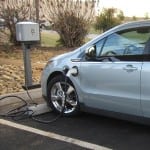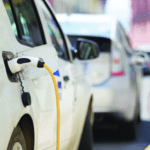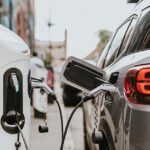The promise of a nationwide network of charging stations to serve drivers of electric vehicles (EVs) received a major boost on Feb. 10, with two federal agencies announcing nearly $5 billion has been earmarked to support such infrastructure.
The U.S. Departments of Energy and Transportation said the money will be made available under the new National Electric Vehicle Infrastructure (NEVI) Formula Program established by the Bipartisan Infrastructure Law, the $1 trillion plan passed by Congress in November 2021. The goal is to build out a national EV charging network, with the funds provided over a five-year period to put stations along so-called “Alternative Fuel Corridors,” primarily along interstate highways in the U.S. The groups on Thursday said $615 million will be made available in fiscal year 2022 under the NEVI program.
“As anyone in the EV sector is aware, network charging infrastructure is the threshold issue to be resolved in order to get more EVs on the roads in U.S. markets,” said Levi McAllister, partner at Morgan Lewis and head of the firm’s EV working group. “The administration’s issuance of the NEVI guidance is a material step to implement the administration’s commitment to encourage EV infrastructure development.”
McAllister told POWER, “Equally important, this issuance is a significant action that is necessary in order to turn on the spigot for at least $5 billion of the $7.5 billion in federal funds allocated to EV charging in November 2021’s infrastructure bill. In today’s guidance, EV sector market participants, state policy makers, and state regulators have insight into the factors and criteria that the federal government deems critical for purposes of funding eligibility.”
Deployment Plans
States must submit a deployment plan for the charging infrastructure before being eligible to access the funds. The federal agencies on Thursday said a second, competitive grant program will be announced later this year, with a goal of providing more charging infrastructure located in rural and underserved communities.
“A century ago, America ushered in the modern automotive era; now America must lead the electric vehicle revolution,” said U.S. Transportation Secretary Pete Buttigieg in a statement. “The president’s Bipartisan Infrastructure Law will help us win the EV race by working with states, labor, and the private sector to deploy a historic nationwide charging network that will make EV charging accessible for more Americans.”
Secretary of Energy Jennifer Granholm said, “We are modernizing America’s national highway system for drivers in cities large and small, towns and rural communities, to take advantage of the benefits of driving electric. The Bipartisan Infrastructure Law is helping states to make electric vehicle charging more accessible by building the necessary infrastructure for drivers across America to save money and go the distance, from coast-to-coast.”
“This announcement demonstrates that clean energy investments deliver for America,” Elizabeth Gore, senior vice president of political affairs at the Environmental Defense Fund, said in a statement. “Building out a national network of charging stations will mean less pollution, more jobs and cleaner cars. It will also allow more Americans to skip paying at the pump by making electric vehicles a practical choice for more working families.”
The Biden administration in the past year has put forth several initiatives in support of electrifying U.S. transportation. The president most recently on Feb. 8 announced that Australian electric vehicle charging company Tritium DCFC Ltd. will build a U.S. manufacturing facility in Tennessee, and said the plant would set off “a ripple effect” of such manufacturing. The White House on Tuesday said the plant, sited in Lebanon, east of Nashville, would create 500 jobs, and produce as many as 30,000 EV chargers each year.
The U.S. currently is the world’s third-largest market for EVs behind China and Europe, according to the Visual Capitalist group.
“The Biden administration’s $5 billion investment will be a catalyst for electric vehicle sales,” Paul DeCotis, senior partner in consultancy West Monroe’s E&U practice, told POWER. “The administration is making a concerted and deliberate effort with the strategic investment being made available for electric vehicle infrastructure along the nations’ roadways to address the most critical issue impeding vehicle ownership. Range anxiety will be eliminated as barrier to ownership, making charging more ubiquitous like your corner gas station.”
Said McAllister: “The NEVI guidance, by its own terms, is designed to and likely will spur EV infrastructure development sooner rather than later. The guidance envisions a fast-track timeline for funding award issuances—requiring states to submit implementation plans and DOT [Dept. of Transportation] to approve those plans later this year so that funds can start to flow in 2022. Moreover, the guidance is written to account for instances where state policy initiatives discourage—rather than encourage—EV development. For example, the guidance provides that funding allocated to states via formulaic application can be rerouted to localities or other projects if a state DOT fails to develop or implement an approved plan that qualifies under the guidance’s criteria.”
Basic Standards
Buttigieg at a news conference Thursday said, “We’re not going to dictate to the states how to do this, but we do need to make sure that there are meet basic standards.” He said rural areas will have different challenges than urban areas in deploying chargers. “It’s got to be customized, which is exactly why we have the states coming to us with plans rather than the other way around,” he said.
Biden has said he wants to make charging EVs in the U.S. “quick and easy,” adding that a charging network is a “foundation [that] will help build America—help American automakers set the pace for electric vehicles, which means even more good-paying jobs producing batteries, materials and parts.”
The president has said he wants 50% of all new vehicles sold to be electric or plug-in hybrid electric models by 2030. He also said the U.S. should have 500,000 new EV charging stations by the end of the decade.
The administration has created a new Joint Office of Energy and Transportation to help distribute federal funding. Each state wanting to participate in the NEVI program will submit their EV Infrastructure Deployment Plan to that new agency, outlining how it will use its share of the program funds, consistent with guidance from the Federal Highway Administration (FHWA).
The aforementioned Alternative Fuel Corridors have been designated in nearly every state over the past several years, and will form what officials on Thursday called the “spine” of the national charging network. Each state’s plans for infrastructure will be reviewed and then subject to approval from the FHWA, which will administer the funding.
Criteria ‘Strikes a Balance’
“The criteria specified in the guidance is clear and, at first glance, strikes a balance between encouraging a national network of EV charging and the pragmatic considerations relating to grid reliability, grid access, and differences in the infrastructure development that may already exist in various geographic regions,” said McAllister, who previously provided commentary for POWER about the Biden’s administration funding plans for EVs.
“Americans need to know that they can purchase an electric vehicle and find convenient charging stations when they are using Interstates and other major highways,” Deputy Federal Highway Administrator Stephanie Pollack said Thursday. “The new EV formula program will provide states with the resources they need to provide their residents with reliable access to an EV charging station as they travel.”
The administration on Thursday said states should first prioritize charging stations along interstate highways. The announcement also said:
- States should fund DC Fast Chargers; stations should have at least four ports capable of simultaneously charging four EVs.
- States should install EV charging infrastructure every 50 miles along interstate highways and be located within 1 mile of highways.
- Federal funds will cover 80% of EV charging costs, with private or state funds making up the balance.
“We’re not going to go electric fast enough if we don’t have the ability to eliminate range anxiety for people and to be able to have them plug in wherever they live, wherever they work, wherever they want to head,” Granholm said as part of Thursday’s announcement.
—Darrell Proctor is a senior associate editor for POWER (@POWERmagazine).










